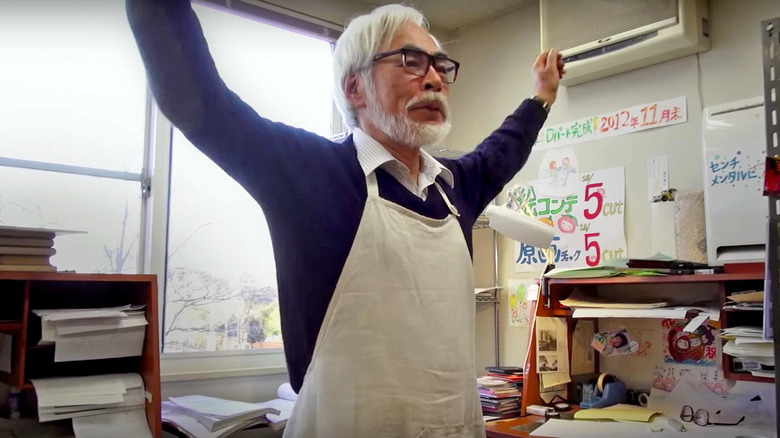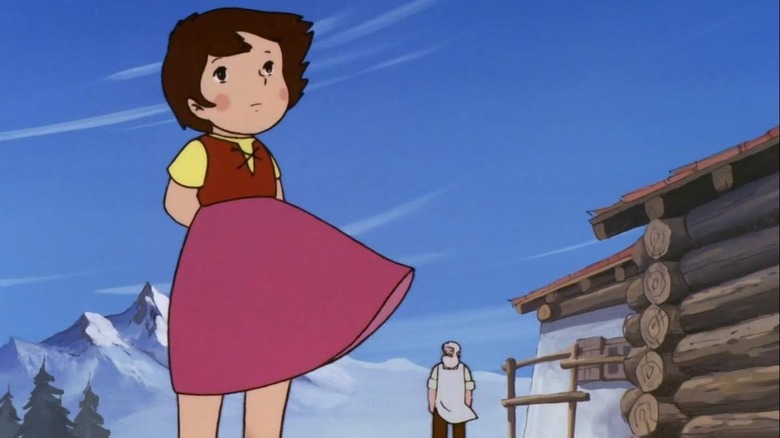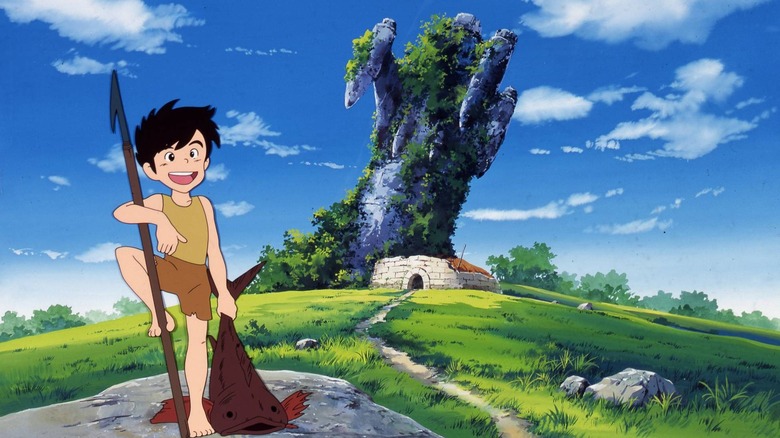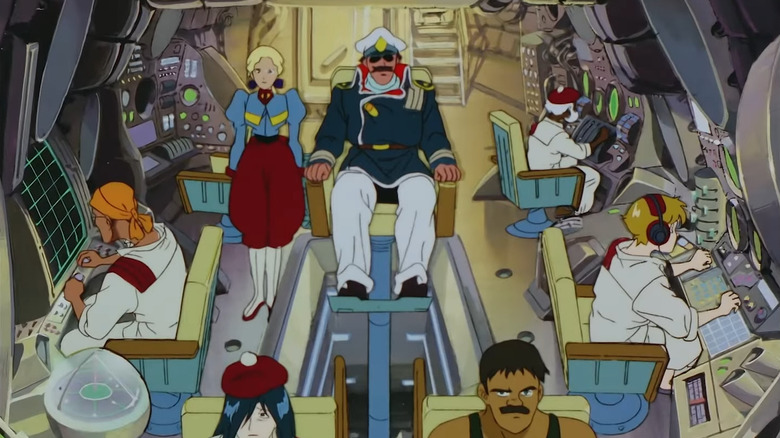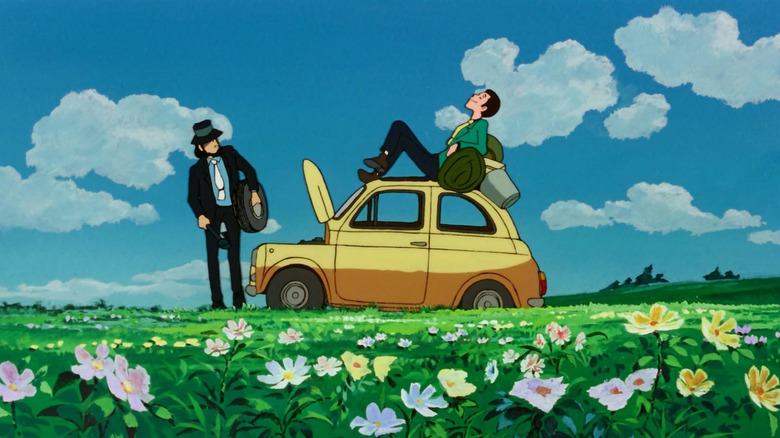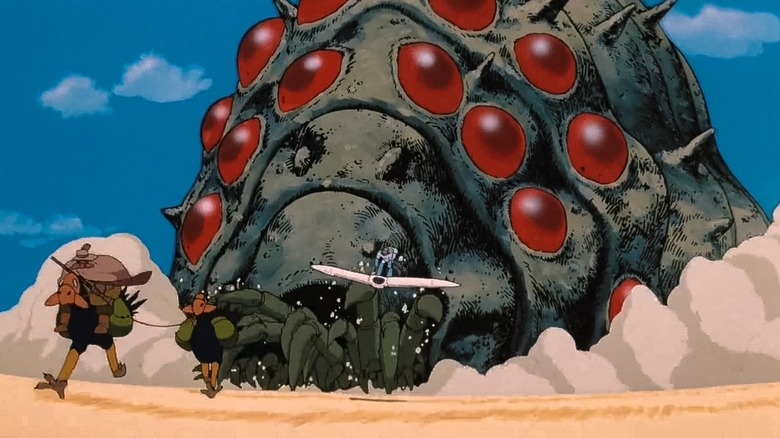Hayao Miyazaki's Pre-Studio Ghibli Movies Hint At The Master Director's Career To Come
Hayao Miyazaki is considered one of the best animators of all time, and his work with Studio Ghibli includes some of the most beloved and acclaimed animated films in the history of the medium. (We even count one amongst our picks for the 100 best movies ever, period.) The animator has helped change anime and animation so much that he refuses to permanently retire, choosing instead to deliver masterpiece after masterpiece and exploring different genres and tones, all while remaining true to his trademark themes and characters — determined heroines, magical realism, and anti-war messages. Miyazaki seems determined to continue working even if it means threatening the future of his studio after he's gone because he's yet to pick a successor.
While many people are familiar with Miyazaki's output with Studio Ghibli, not many know about his work prior to co-founding the studio with Isao Takahata and Toshio Suzuki. And yet, it is in that pre-Ghibli era that we find hints of the maestro that Miyazaki would become, as well as the elements he would return to time and time again in his films.
Miyazaki's collaborations with Isao Takahata
Arguably Miyazaki's most important collaboration is his partnership with Isao Takahata, whom he long considered to be a mentor. This relationship not only gave us some of the greatest works of animation of the past 50 years, but also directly resulted in the creation of Studio Ghibli — not to mention it directly informed Miyazaki's latest movie, "The Boy and The Heron."
In the '70s, Takahata brought Miyazaki along on many of his productions, helming some of the most influential and celebrated anime TV shows of the decade. Sadly, many of these works were never broadcast in the U.S., although they became immensely popular everywhere (from Latin America all the way to the Middle East).
Titles like "Heidi, Girl of the Alps," "Anne of Green Gables," and "3000 Leagues in Search of Mother" loosely adapted works of literature and were part of a push by Nippon Animation to make children's shows based on books. Miyazaki contributed scene designs and layouts in addition to writing several episodes of these series, although they were mostly Takahata's handiwork. Still, these ventures cemented a creative partnership that resulted in the founding of Ghibli.
These shows also have early hints of the Ghibli hallmarts that Miyazaki would return to time and time again. The character designs are simultaneously cartoonishly childish yet grounded and realistic, while the shows' character animation and the way characters run are reminiscent of Miyazaki's later work. There is also the combination of a child-like sense of wonder and a dark, dangerous world that constantly challenges the protagonist. This is where Miyazaki's career as a writer begins properly.
Future Boy Conan marked the start of Miyazaki's directing career
Miyazaki made his debut as a director in 1978 with "Future Boy Conan," an anime series based on Alexander Key's 1970 novel "The Incredible Tide." It is set in 2008 after the world has been ravaged by war and thrown off its axis, with the continents having sunk into the sea. The story follows a boy named Conan, who has superhuman strength and joins a fight against a group of nefarious villains hoping to control what is left of civilization.
Though "Future Boy Conan" did not strike as big as Takahata's shows (possibly because it was much, much weirder, whereas Takahata's series were much more accessible), there are clear hints of the work Miyazaki would do with Ghibli in this anime. For one, the character designs are quintessential Miyazaki, and there is a clear love of planes, including their look and movement, in the show that would permeate the rest of Miyazaki's output, from "Castle in the Sky" all the way to "The Wind Rises." The series also features giant creatures that look straight out of "Princess Mononoke," as well as an anti-war theme that is reminiscent of that movie, too.
Miyazaki lent a hand to Sherlock Hound and Nadia
"Sherlock Hound" and "Nadia: The Secret of Blue Water" are both titles that Miyazaki worked on initially, but wasn't super involved with and ultimately left to others to complete.
While he served as a director on the former show, it was only for the first six episodes. The story really is just "Sherlock Holmes" with dogs, but the episodes are visually stunning and fun to watch. There are even echoes of Miyazaki's later work on "Lupin the Third." Ultimately, however, the Sir Arthur Conan Doyle estate took issue with the show and suspended production, after which Miyazaki left due to other commitments. Still, something stuck with him, seeing as his next show had similar Jules Verne-style steampunk vibes, as did many other projects he would later work on. The idea of anthropomorphic animal characters and magical creatures in "Sherlock Hound" is also something he'd revisit in the future, most pointedly with "Porco Rosso."
Meanwhile, "Nadia: The Secret of Blue Water" was based on an idea by Miyazaki and inspired by Verne's writing, especially "Twenty Thousand Leagues Under the Seas." Originally, Miyazaki wanted to make a show called "Around the World in 80 Days by Sea," but after it fell apart, he cannibalized the concept and incorporated elements of it into everything from "Future Boy Conan" to "Castle in the Sky."
"Nadia," as it were, takes place in an alternate universe circa 1889. There, a teen girl named Nadia is pursued by jewel thieves seeking a pendant she owns. She's eventually rescued by Captain Nemo on the Nautilus and they join forces to battle the Neo-Atlanteans (who seek world domination), all while exploring mysteries of the world and Nadia's secret origins and powers. The show was directed by the great Hideaki Anno, who Miyazaki mentored for a while, and features several Miyazaki staples, including a plucky female hero with an inextricable connection to nature. Overall, though, it mostly feels like Anno's work (he initially envisioned "Evangelion" as a sequel to this show).
Miyazaki's The Castle of Cagliostro heralded a genius' arrival
"The Castle of Cagliostro" marked Miyazaki's feature directorial debut, and it showed that he could not only build creative, weird worlds, but he could also make incredibly fun movies — even when working with an established franchise (Miyazaki had previously directed episodes of the first "Lupin the Third" anime alongside Tahakata).
"Castle of Cagliostro" is a reimagining of "Lupin the Third," the long-running anime show about the gentleman thief Arsène Lupin III. This is by far the most accessible and purely fun of Miyazaki's films, a spectacular pulp comedy adventure not heavy with themes, but simply — as our own Ben Pearson once described it – "a blend of heart, humor, romance, adventure, and comedy." In a way, this is Miyazaki doing an Indiana Jones movie.
Much like "Sherlock Hound," this film features a vaguely European setting (a concept which Miyazaki would also use in movies like "Porco Rosso" and "Kiki's Delivery Service") and includes plenty of fun car chases. "Castle of Cagliostro" was not only a big hit, but a rather influential movie, with Disney Animation's "The Great Mouse Detective" paying homage to the film with its climactic showdown on Big Ben.
Nausicaä of the Valley of the Wind led to Ghibli
Though "The Castle of Cagliostro" proved Miyazaki could work with a bigger budget in a feature format, it was "Nausicaä of the Valley of the Wind" that heralded the arrival of an animation powerhouse.
While "Nausicaä" is often referred to as a Ghibli movie and has even been re-released with the Ghibli logo in recent years, it wasn't actually produced by Ghibli. Still, it represents the culmination of years of work, combining Miyazaki's influences with certain elements he'd picked up from his previous endeavors. There's the strong, plucky heroine, the steampunk aesthetic, the environmentalism and anti-war messages, the planes, the creatures and monsters, and, not least of all, the moral ambiguity. It's also just a very good movie that feels like Miyazaki's answer to "Dune."
It's easy to see why "Nausicaä" is typically mistaken for a Ghibli movie — because it very much feels like one. It features music by longtime Ghibli composer Joe Hisaishi, was produced by Toshio Suzuki, and even had Hideaki Anno reuniting with Miyazaki again after "Nadia" (with Anno animating the Giant Warrior's attack sequence, which is a highlight of the film). It marked, for all intents and purposes, the birth of Ghibli, with the film's success leading directly to Miyazaki, Takahata, and Suzuki teaming up to found the legendary studio shortly afterward.
Unsurprisingly, "Nausicaä" wasn't as big a success in the U.S.; the domestic cut of the film was heavily edited, with themes being simplified and character names getting completely changed. In fact, Miyazaki was so dissatisfied with the localization that he adopted a strict no-edits policy for his movies after that.
